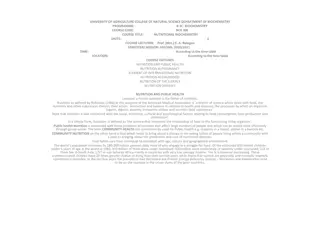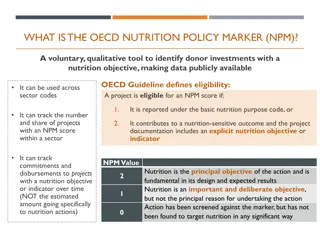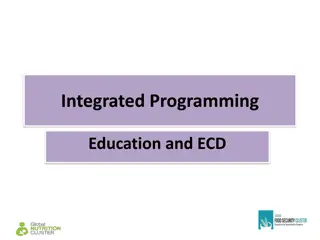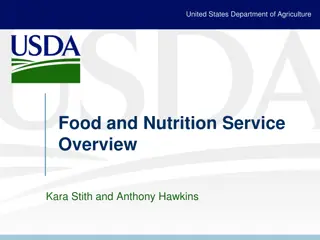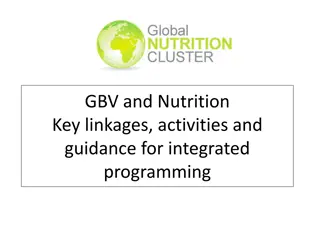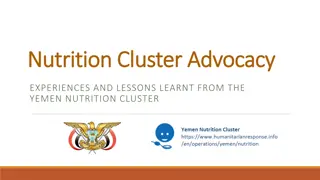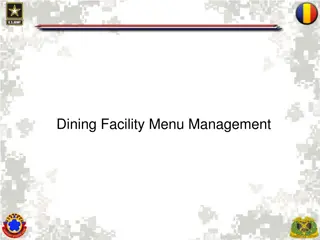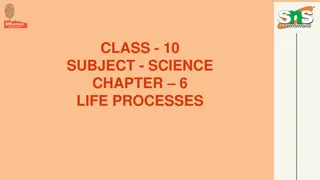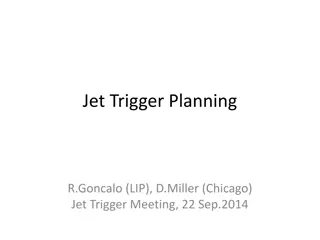Understanding Nutrition and Menu Planning for Health
Explore the basics of nutrition and menu planning to maintain a healthy diet. Learn about the five essential food groups, nutrients, their functions, and classification. Discover how digestion and absorption play a vital role in utilizing nutrients effectively. Understand food requirements for different age groups and gain insights into creating a balanced diet for optimal well-being.
Download Presentation

Please find below an Image/Link to download the presentation.
The content on the website is provided AS IS for your information and personal use only. It may not be sold, licensed, or shared on other websites without obtaining consent from the author. Download presentation by click this link. If you encounter any issues during the download, it is possible that the publisher has removed the file from their server.
E N D
Presentation Transcript
Module 1 The five basic food groups SOURCES OF NUTRITION The five basic food groups are foods that we need to eat from every day to stay healthy. The five basic food groups are: Group 1: Protein and meat group; Group 2: Calcium and milk group; Group 3: Fruit and vegetables group; Group 4: Cereal group; and Group 5: Fats and oils group. www.futuremanagers.com
Module 2 Nutrients TERMINOLOGY Food is any substance, liquid or solid which provides the body with materials necessary for important functions. Nutrients are the components in food that must be supplied to the body in suitable amounts to be able to perform the important functions. A balanced diet is a diet that contains adequate amounts of all the necessary nutrients required for the needs of an individual at a particular stage in his life. www.futuremanagers.com
Module 2 Nutrients (continued) FUNCTIONS OF NUTRIENTS The nutrients that are needed by the body and are obtained from food can be divided into three groups, according to their functions: Group A B C Functions Energy processes Growth and repair Regulate body processes Nutrients Carbohydrates Fats Proteins Proteins Minerals Water Vitamins Minerals Water www.futuremanagers.com
Module 2 Nutrients (continued) CLASSIFICATION OF NUTRIENTS Proteins: Complete, semi-complete and incomplete proteins. Fats: Fats and oils. Carbohydrates: Monosaccharides, disaccharides and polysaccharide. Vitamins: Vitamin A, Vitamin S, Vitamin E, Vitamin K, Vitamin B Complex, Vitamin B1, Vitamin B2, Vitamin B6, Vitamin B12, and Vitamin C. Minerals: Calcium, Phosphorus, Iron, Sodium, and Iodine. Water. www.futuremanagers.com
Module 2 Nutrients (continued) DIGESTION AND ABSORPTION When food has been eaten, it must be broken down in the body by the process of digestion. Absorption occurs after the food has been broken down; the products are then passed through the walls of the digestive tract into the bloodstream. www.futuremanagers.com
Module 3 Food requirements and nutritional guidelines FOOD REQUIREMENTS OF THE DIFFERENT AGE GROUPS Pregnant women: Needs nutrients for the foetus to develop properly. Babies: Depends entirely on milk or the first four to six months of life. Toddler: Milk, meat, fruit and vegetables groups are needed. Children: Should include dark leafy greens and whole-wheat breads and cereals. Teenagers: Nutrients to cope with growth and hormonal changes. The elderly: Small, nutrient filled meals more often. www.futuremanagers.com
Module 3 Food requirements and nutritional guidelines (continued) VEGETARIANS Vegetarianism is the practice of abstaining from consumption of meat (red meat, poultry and seafood). It may also include abstention from by-products of animal slaughter, such as animal derived rennet and gelatine. www.futuremanagers.com
Module 3 Food requirements and nutritional guidelines (continued) FOOD ALLERGIES A true food allergy is a reaction of the immune system as a result of eating a specific food and can in many cases be tested clinically because of changes in the immune system. www.futuremanagers.com
Module 3 Food requirements and nutritional guidelines (continued) EFFECTS OF RELIGION Around the whole world religion always has, and still does, affect what many people eat. Some people s diets are restricted daily by their religion and others are influenced by what they eat on special occasions. www.futuremanagers.com
Module 3 Food requirements and nutritional guidelines (continued) NUTRITIONAL GUIDELINES WHEN COMPILING MENUS FOR INSTITUTIONS The South African Food-Based Dietary Guidelines: Enjoy a variety of foods; Meat, fish, chicken, milk or eggs can Make starch the basis of meals; be eaten daily; Eat plenty of vegetable and fruit daily; Use salt sparingly; Eat legumes regularly; Drink lots of clean, safe water; Eat fats sparingly; Drink alcohol sensibly. www.futuremanagers.com
Module 3 Food requirements and nutritional guidelines (continued) SOUTH AFRICAN LOCAL CULTURAL GROUPS Most nations are composed of various sub-cultures with different preferences. Factors which influence traditional eating habits include: Environmental factors; Religious factors; and Cultural factors. www.futuremanagers.com
Module 3 Food requirements and nutritional guidelines (continued) INTERNATIONAL CUISINE African: Babotie, groundnut stew, ugali, ful medames; Indian: Chapati, ghee, poppadums, bombay duck, vindaloo; Middle-Eastern: Couscous, kebabs, keftdes, hummus, tahini; Asian: Gado gado; Japanese: Sushi, teriyaki, yakitori, mirin, tofu, sake; European: Fried fish and chips, Welsh lamb pie, haggis, Irish stew; American: Gumbo, chowder, cheesecake, jambalaya. www.futuremanagers.com
Module 4 Modified diets MODIFICATION IN TEXTURE Dietary modification means altering the consistency of foods and liquids. Three types of modified-texture diets: 1. Pur ed diet; 2. A minced, ground and chopped diet; and 3. A modified regular diet. www.futuremanagers.com
Module 4 Modified diets (continued) SPECIAL DIETS Special diets include: Low-fat diets; Low-sodium diets; Low protein diets. www.futuremanagers.com
Module 4 Modified diets (continued) REDUCING DIETS: BASIC PRINCIPLES, FOOD ALLOWED AND FOOD TO AVOID It takes more than just eating low-fat foods to lose weight one must also watch how many calories one eats. Trans fats, cholesterol and sodium are recommended to avoid when dieting. www.futuremanagers.com
Module 4 Modified diets (continued) HEALTH TRENDS IN NUTRITION Different health trends include: Lowering cholesterol content; Lowering fat content; Raising fibre content; and Lowering fibre content. www.futuremanagers.com
Module 5 Menu planning TERMINOLOGY A menu is a detailed list of food to be served at a specific meal, in a specific order, offered by a food service unit, which inform the customer what the caterer has to offer. A cycle menu is compiled over a given period of time and consists of a number of set menus that are rotated for a particular establishment. www.futuremanagers.com
Module 5 Menu planning (continued) THE MENU AS A TOOL OF MARKETING The menu is used as a: Purchasing guide; Means of advertising food and beverages; Form of merchandising and an important marketing tool; A design to appeal to the guests and to stimulate sales; Size easily handled, spotlessly clean and simple in format; highly legible and interesting in colour and design. www.futuremanagers.com
Module 5 Menu planning (continued) PRE-PLANNED AND PRE-DESIGNED MENUS ADVANTAGES Good menu planning is practised. After planning, there is time for the planner to review and revise menus to meet changing needs. Repetition aids in standardising preparation and efficient use of equipment. The quality of food is likely to be higher because kitchen staff have prepared dishes before. Menus are planned and costed in advance and the manager can quote prices immediately to a customer. Purchasing, production and service can be simplified. DISADVANTAGES The customer may get tired of the same food. It s a long period of initial planning. It may reduce job satisfaction for staff who have to prepare the same dishes. It may limit the chef s creativity. It may not provide for foods that come into the market at different times of the year. www.futuremanagers.com
Module 5 Menu planning (continued) STRUCTURE OF THE MENU Several aspects to consider when drawing up a menu include: Length; Design; Language; and Presentation. www.futuremanagers.com
Module 5 Menu planning (continued) FOOD COMBINATION WHEN PLANNING A MENU When planning menus, one must visualise how the food will look on the plate and sense the combinations of food presented, how the flavours will combine, and whether there is a contrast in texture, shape and consistency. www.futuremanagers.com
Module 5 Menu planning (continued) ESSENTIAL CONSIDERATION PRIOR TO PLANNING THE MENU Location of the establishment and competition in the locality; Suitability of a particular establishment to a particular area; The type of people to cater for and customer requirements; Number of items and price range of menus; Space and equipment in the kitchen and supplies and storage; Seat turnover and spending power of customers; Capability and amount of labour. www.futuremanagers.com
Module 5 Menu planning (continued) FACTORS TO BE CONSIDERED WHEN COMPILING A MENU Type of establishment; Appropriate language; Type of customer; Nutritional balance; The religious rules if applicable; The occasion; Meat and non-meat preferences; The menu; Timing; Leftover foods. Pricing; Number of courses; www.futuremanagers.com
Module 5 Menu planning (continued) TYPES OF MENU Table d hote menu; Buffet menu; la Carte menu; High tea; Plat du jour; Dinner menu; Special function menu; Supper menu; Breakfast menu; Room service menu; Brunch menu; Canteen menu; Lunch menu; Cycle menu. www.futuremanagers.com
Module 6 Modern service order COURSE, HORS D OEUVRES, FARINACEOUS, ENTR E A course is one of the sections of a meal. Hors d oeuvres is the name given to a wide variety of foods. Farinaceous are foodstuffs that consist of a large amount of starch. Entr es are generally small, well-garnished dishes that are plate-served individually. www.futuremanagers.com
Module 6 Modern service order (continued) NORMAL ORDER IN WHICH DISHES ARE SERVED The normal order in which dishes or courses appear on the classic menu is as follows: Entr e; Sweets; Hors d oeuvres; Soup; Joint; Savoury; Eggs; Vegetables; Cheese; Rice and pasta; Poultry/Game or Roast; Dessert; Fish; Salads; Beverages. www.futuremanagers.com
Module 6 Modern service order (continued) DIFFERENT BREAKFAST MENUS Breakfast menus can be divided into TWO main categories: 1. Full English breakfast; 2. Continental breakfast. www.futuremanagers.com
Module 6 Modern service order (continued) LUNCHEON MENUS: SEQUENCE OF DISHES A traditional lunch menu might include the following courses: Starter; Fish; Main; Sweet; Cheese; Coffee. www.futuremanagers.com
Module 6 Modern service order (continued) ENTR ES AND RELEV S The entr e is the first of the meat courses. At dinner, usually, it is complete in itself, accompanied by its own vegetable or other garnish. The relev is a larger joint or pi ce de resistance www.futuremanagers.com
Module 6 Modern service order (continued) SUPPER MENUS: SEQUENCE OF DISHES Normally set supper menu consist of three courses only, with many choices in the second or main course. These choices include: Second course: Fish, Entr es, Roasts, Grills, and Salads. Third course: Hot and cold sweet desserts; Savoury, Cheeses, and Coffees. www.futuremanagers.com
Module 6 Modern service order (continued) FUNCTION MENU PLANNING The different courses of a luncheon menu for a function could include: 1. First course; 6. Sweet; 2. Fish; 7. Cheese; 3. Main course; 8. Dessert; 4. Cold buffet; 9. Coffee. 5. Vegetable dish or cold dish; www.futuremanagers.com
Module 6 Modern service order (continued) PRE-BANQUET ORGANISATION A banquet is a public or private meal for many people that have celebratory or ceremonious meaning. There are many things to consider when planning a banquet: Allergy information; Details regarding the building s facilities; Potential food storage; and Preparation areas. www.futuremanagers.com
Module 6 Modern service order (continued) AFTERNOON TEA The order of service for afternoon tea is: 1. Beverages 7. Preserves 2. Hot snacks-bread and butter 8. Cakes and pastries 3. Hot toasted items 4. Sandwiches 5. Buttered scones 6. Bread and butter www.futuremanagers.com
Module 6 Modern service order (continued) SELECTING TABLE WINE AND A WINE LIST The aim of the wine list is similar to that of the menu and should be regarded as a marketing tool for the restaurant. It should therefore be attractive and interesting. Prices should be indicated clearly. www.futuremanagers.com
Module 7 Fixed menus, menu specification, order forms and dispatch list TYPES OF FIXED MENUS Cycle menus; Traditional table d'h te menu used in hotels and restaurants; and Fixed menu with a limited choice. www.futuremanagers.com
Module 7 Fixed menus, menu specification, order forms and dispatch list (continued) MENU SPECIFICATIONS Menu specification indicates the manual that gives the chef all the technical information on how to plan a menu for the restaurant or catering function. The specifications include: Length; Design; Language; and Presentation. www.futuremanagers.com
Module 7 Fixed menus, menu specification, order forms and dispatch list (continued) THE FUNCTION ORDER FORM The function order form, also called the function sheet, lists the details of the event in what will become an important document. The point of a well-written function order is to answer all questions at once, so it should carry every detail available. www.futuremanagers.com






